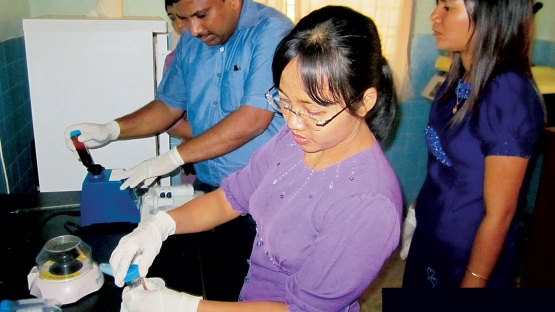Recent political reforms and engagement with global markets have revitalized the economic growth of the Republic of the Union of Myanmar. This has meant increased purchasing power for the population and with it, increased incorporation of meat, milk and other animal-origin foods in the national menu. In addition to food, livestock also provides almost all the power and organic fertilizers used in crop production, which are instrumental in improving the country’s rural livelihoods and food security. Assistance from the Joint FAO/IAEA Division has supported Myanmar in developing laboratories with molecular and nuclear techniques for genetic characterization of domestic animals, for delivering services to farmers that support animal breeding and for diagnosis and control of transboundary animal diseases. A new capacity to incorporate marker-assisted selection into an effective cattle breeding programme will also enable sustainable growth in the sector, allowing it to keep up with the expected growth of Myanmar’s economy.
Molecular Laboratory Supports Sustainable Growth of Myanmar Livestock Sector

The Government of Myanmar has prioritized its livestock sector as a tool to address poverty reduction and rural livelihood development. As an agriculture-based country, Myanmar relies heavily on livestock, not just for meat and milk production but also for draught power and manure to support crop production, all of which are critical for improving rural livelihoods and enhancing food security. The livestock and fisheries sector is responsible for 7.6 per cent of the country’s total GDP.
Moving to further improve the sector, Myanmar has developed an animal genetics laboratory with the assistance of the Joint FAO/IAEA Division. Most of the country’s indigenous cattle are draught animals, meaning they can work long hours tilling agriculture fields and pull carts with heavy loads. The genetics laboratory has now characterized Myanmar’s three major breeds of cattle: Pyar Zein, Shwe Ni and Shwe Ni Gyi. Using molecular genetic analysis, the laboratory determined that Shwe Ni is a unique breed, distinct from Shwe Ni Gyi and Pyar Zein. This information will enable specialists to develop a selective breeding programme to develop Shwe Ni and Pyar Zein as dual purpose breeds that use females for milk and males for draught, and Shwe Ni Gyi as a dairy-type breed. This programme will involve animal identification, performance recording and the improvement of animal feeding and management.
Improved lab capacity leads to commercial dairy industry

Myanmar first introduced artificial insemination (AI) in 1975 using semen of exotic cattle breeds such as Friesian, Jersey and Norwegian Red to improve the milk productivity of local cattle. Facilities for collection and preservation of bull semen for an AI programme have now been established in the country. This includes training staff, procuring necessary equipment and developing and implementing protocols for running the AI programme. In 2013, the programme made about 32 000 AIs using frozen semen – over five times more than the 6 000 AIs done in 2004. In addition, Myanmar has developed a gene bank with a large repository of frozen semen.
The use of AI, improved forage management and extension activities from the Ministry of Agriculture Livestock Breeding and Veterinary Department have contributed to the development of several peri-urban dairy farming communities. In 2004, cattle rearing was considered a subsistence activity for crop production, and only a few market-oriented dairy farms existed – in Yangon and Mandalay. By 2013, Yangon had 10 commercial dairy farms, each with 80 to 520 head of cattle that produced more than 5 000 litres of milk a day. Similarly, the Mandalay region had 11 commercial dairy farms that collectively produced about 3 000 litres of milk. Along with this increase in the number of commercial dairy farms and cattle, the sector has seen a clear trend in increased milk production per farm and per cow which has contributed substantially to providing consumers with milk from domestic sources.
Animal disease laboratory produces FMD vaccines

The Myanmar livestock industry has been challenged by many transboundary animal diseases such as foot-andmouth disease (FMD) which is endemic in the country. To counter the potential contraction of FMD in large populations of FMD-susceptible animals – currently estimated at 13.6 million cattle, 3.0 million buffaloes, 9.3 million pigs and 4.0 million sheep and goats – the National FMD Laboratory, which is supported by the Joint FAO/IAEA Division, produces about 200 000 doses of FMD vaccines for cattle and 50 000 doses of FMD vaccines for pigs annually. This number of doses is still low, but is a good start.
A new biosecurity level-2 (BSL-2) FMD vaccine and diagnostic facility, being built in Yangon with funding from the Government of Myanmar and the Japanese International Cooperation Agency (JICA) and technical assistance from the Joint Division, is expected to release FMD vaccines to be used in the field by the end of 2015. Additionally, a new FMD diagnostic laboratory is being constructed with financial support from the Myanmar Government and the Korean International Cooperation Agency (KOICA).
The Joint Division supports networking among Member States and, in this case, additional support from Japan and Korea further boost Myanmar’s efforts for the improvement of animal health and productivity with the ultimate goal of enhancing sustainable food security in the country.


